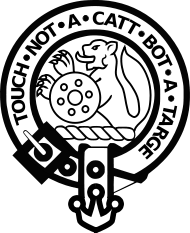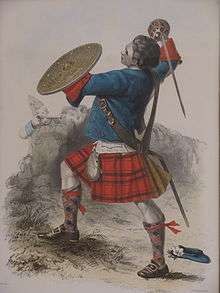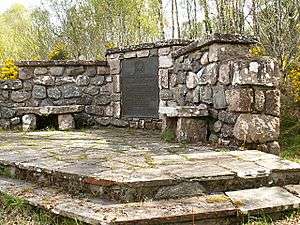Clan MacBean
| Clan MacBean | |||
|---|---|---|---|
| MacBeathain | |||
 Crest: Wildcat holding a shield known as a Targe | |||
| Motto | Touch Not A Catt Bot A Targe[1] | ||
| War cry | Kinchyle | ||
| Profile | |||
| Region | Highland | ||
| District | Inverness | ||
| Plant badge | Boxwood or red whortleberry[1] | ||
| Animal | Scottish Wildcat | ||
| Chief | |||
 | |||
| James McBain of McBain | |||
| 22nd Chief of Clan MacBean | |||
| Historic seat | Kinchyle in the parish of Dores, Inverness-shire.[2] Tomatin, in Strathdearn and Faillie, in Strathnairn | ||
| |||
| |||
| |||
| |||
Clan MacBean[3] (or Clan MacBain),[4] is a highland Scottish clan and is a member of Clan Chattan.[4]
History
Origins
Origins of the clan's name
There could be several possible Gaelic origins for this name,[4] with bheathain (lively one) being the most likely.[4] Another likely origin for the name is the gaelic Bàn[5] ('Fair' / 'White' in English), which appears in the name of Scottish King Donald Bàn - the name could be a reference to the colour of his hair[6][7] and/or the paleness of his face. A third, but perhaps less likely origin of the name is the suggestion[8] that the name originated from 'Beann' (otherwise 'beinn'), which means 'top'/'peak',[9] as applied to the names of mountains such as Beinn a' Chaorainn in Lochaber and Britain's highest mountain Ben Nevis (Gaelic: Beinn Nibheis). If the name did arise from 'Beann' then one might assume it was a reference to the height of the person it was applied to.
An authoritative view on the origin of the name MacBean came from the respected Gaelic academic Alexander MacBain who, in his An Etymological Dictionary of the Gaelic Language, wrote the following words:
MAC-BEAN, G (i.e. Gaelic). McBheathain, from Beathan, Englished as Bean (1490, Beane, 1481) or Benjamin: *Bitâtagno-s, life's son, from beatha, life, with the termination -agno-s, meaning "descendant of," Eng. -ing, now used like the Eng. to form diminutives. Also Mac-bain, Mac-vean.[10]
If one pronounces the name McBeathain without use of the usual English "th", but lightly skip over it, as one would do in Gaelic, one can easily see how the name was then written as MacBean, McBain etc.
However, Alexander MacBain also provided a view on the origin of the name 'Bain' in the same dictionary, which supports the name having arisen from 'Bàn':
BAIN, from G (i.e. Gaelic). Bàn, white. The Bains of Tulloch appear in the sixteenth century variously as Bayne or Bane, with a contemporary near them called John Makferquhair McGillebane (1555). This last name is now McIlle-bhàin, "Fair-gille," rendered into Eng. by Whyte; whence also McGilvane.[11]
As detailed further below, despite the similarity of the name, it is important to note that the Bains of Tulloch are not related to or a part of Clan MacBean.
Early History - descent from Gillichattan Mor and Clan Chattan
History and tradition ascribes the MacBeans as being among the descendants of Gillichattan Mor more commonly known as Clan Chattan.[12] The earliest certain record of the name in its more modern form appeared in an old Kinrara manuscript, which names both Bean Macmilmhor and his son, Milmor MacBean.[13]
Charles Fraser-Mackintosh provides some helpful information about the clan's origins:[14]
The Macbean territory lay chiefly in the parish of Dores, as may be seen from the preponderance of the name on the tombstones in the churchyard, represented by Kinchyle and Drummond as heritors.
They were represented in Strathnairn by Macbean of Faillie, and in Strathdearn by Macbean of Tomatin. Kinchyle was undoubted head, and signs the Bond of Union among the Clan Chattan in 1609; the Bond of Maintenance of 1664; and finally, in 1756, the Letter of Authority from the Clan to Mackintosh, to redeem the Loch Laggan estate.
According to the Rev. Lachlan Shaw, the first Macbean came out of Lochaber, in the suit of Eva, heiress of Clan Chattan, and settled near Inverness. The MS. history of the Mackintoshes says in corroboration, that “Bean vic Coil Mor (of whom the Clan Vean had their denomination) lived in Lochaber, and was a faithful servant to Mackintosh against the Red Comyn, who possessed Inverlochie, who was a professed enemy of Mackintosh.”
Again the manuscript records that Myles Mac-Bean vic-Coil-Mor and his four sons, Paul, Gillies, Myles and Farquhar, after they had slain the Red Comyn’s steward and his two servants Patten and Kissen, came to William Mackintosh, seventh of Mackintosh (son of Eva), in Connage, in Pettie, where he then dwelt, and for themselves and their posterity took protection and dependence of him and his, as their chief. This occurring about 1334, establishes the Macbeans as one of the oldest tribes of historic Clan Chattan.
The Mackintosh history, referring to the battle of Harlaw (1411), narrates that “Mackintosh lost in this battle many of his friends and people, especially of the Clan Vean.” This loss so greatly depressed the Macbeans that I am unable to trace the succession from this period until the time of Gillies, about 1500.[14]
The Mackintosh history being referred to above is the Kinrara Manuscript, a new edition of which, edited by Dr Jean Munro has been published by the Clan Chattan Association.[13]
15th, 16th and 17th centuries

The Clan MacBean fought for Domhnall of Islay, Lord of the Isles, along with the rest of the Chattan Confederation at the Battle of Harlaw in 1411, where they suffered heavy losses.[4] In the history of the Mackintoshes, chiefs of Clan Chattan, it is recorded that "Mackintosh mourned the loss of so many of his friends and people, especially of Clan Vean".[4][13]
In 1597 the Bain family of Tulloch Castle fought in the Battle of Logiebride against the Mackenzies,[15] however the Bain of Tulloch family were not part of the Clan MacBean (MacBain) and were in fact a branch of the Clan Mackay, who had changed their surname to Bain.[16][17][18][19] Despite the lack of connection between the Bains (Baynes) of Tulloch and Clan MacBean, a slight connection came later when Kenneth Bayne, 8th Laird of Tulloch sold the estate to his cousin Henry Davidson, whose successors became chiefs of Clan Davidson, members of Clan Chattan like the MacBeans.
The 12th chief of Clan MacBean was Paul MacBean who due to heavy debts was forced to give up his lands in about 1685.[4] However, the lands were re-granted in the same year by the Earl of Cawdor (Calder) to Paul's son William MacBean in Kinchyle.[14] William's elder son Aeneas MacBean succeeded him, followed by his second son Gillies MacBean who fought and died at Culloden.[14][20][21]
The present chiefs descend from a younger son of William MacBean as the older brother's lines ended in daughters.[14][20][21] The copy of the grant of arms of McBain of McBain by The Lord Lyon to Hughston McBain as 21st chief confirms that the line of succession passed via Hughston's great great grandfather William McBain of Pittourie, and states: Which William was great-grandson and eventual Representative of William McBean of Kinchyle, Chief of the Clan McBain.[21][22] This matriculation was listed in The Edinburgh Gazette, 27 May 1966.[23]
18th century and Jacobite risings

Many of Clan MacBean supported the Jacobite rising of 1715 and as a result many of them were transported to the plantations in Virginia, Maryland and South Carolina.[4] However this did not deter Gillies MacBean (sometimes known as Gillies Mor MacBean), 2nd grandson of the 12th chief William MacBean of Kinchyle (his older brother was Aeneas MacBean of Kinchyle) from fighting in the Jacobite rising of 1745.[4] Gillies MacBean took up a commission as a major and fought at the Battle of Culloden.[4] He is said to have been at least 6 feet four inches tall, and the story goes that during the battle he saw government dragoons breaking through to assault highlanders on their flank.[4] Gillies threw himself into the gap and cut down thirteen or fourteen of his assailants, fighting with his back to the wall.[4] A government officer tried to call back his men to save a fellow brave soldier but MacBean was killed.[4] Also at the Battle of Culloden, another MacBain is credited with assisting the chief of Clan Cameron (Lochiel), who was wounded and unable to walk to escape.[4] Another MacBean, Aeneas MacBean (of Faillie) managed to escape after the battle by repeatedly leaping from one side of a stream to another until his pursuers were forced to give up.[4]
After the Battle of Culloden the chief struggled to keep his lands and they were sold in 1760.[4] In 1778 Lieutenant General Forbes Macbean was appointed the commander of artillery in Canada.[4]
Later clansmen
William MacBean extraordinarily rose from the rank of private to Major General and won the Victoria Cross for gallantry during the Indian Mutiny in 1858.[4]
Forbes Macbean, another of the well known military family descended from Reverend Alexander MacBean of Inverness (mentioned above), won a DSO (Distinguished Service Cross) in 1897 when serving as a Major in the Gordon Highlanders, for the gallant and courageous action in taking the heights of Dargai near the border of Afghanistan, in India's old north west province, which is now part of Pakistan. Various accounts of this action have been written.[24] Forbes Macbean later commanded the Gordon Highlanders regiment against the Boers of South Africa in 1881 during the Boer Wars.[25] He is mentioned in an account of the bravery of the Gordon Highlanders at Doornkop (or Florida), south-west of Johannesburg.[20] John Stirling recorded in his book 'Our Regiments in South Africa 1899-1902' that The Gordons were led by Lieut.-Colonel Burney and by Colonel Forbes Macbean, who has perhaps seen more hard fighting than any officer now alive and with his regiment.[26]
The chiefly line of the clan has flourished in Canada and the United States in the 20th century.[4]
Chiefs' Home
- Kinchyle which is six miles south-west of Inverness was the historic seat of the chiefs of Clan MacBean until it was sold in 1759.[27]
See also
References
- 1 2 Clan MacBain Profile scotclans.com. Retrieved 24 November 2013.
- ↑ Coventry, Martin. (2008). Castles of the Clans: The Strongholds and Seats of 750 Scottish Families and Clans. pp. 355. ISBN 978-1-899874-36-1.
- ↑ Clan MacBean and Clan Chattan's own usage of the spelling of the name.
- 1 2 3 4 5 6 7 8 9 10 11 12 13 14 15 16 17 18 19 Way, George and Squire, Romily. (1994). Collins Scottish Clan & Family Encyclopedia. (Foreword by The Rt Hon. The Earl of Elgin KT, Convenor, The Standing Council of Scottish Chiefs). pp. 206-207.
- ↑ Gaelic Place Names of Scotland
- ↑ 'Dhòmhnall / Donald Bàn' - The Gaelic-English Dictionary by Colin B.D. Mark
- ↑ 'Domnall Ban' - A Dictionary of Scottish Phrase and Fable by Ian Crofton
- ↑ The Highland clans of Scotland; their history and traditions by George Eyre-Todd (page 218)
- ↑ An Etymological Dictionary of the Gaelic Language, Alexander MacBain (See page 32 in the 1982 Reprint by Gairm Publications of the 1911 edition)
- ↑ An Etymological Dictionary of the Gaelic Language by Alexander MacBain (page 405, 1982 reprint of 1911 2nd edition)
- ↑ An Etymological Dictionary of the Gaelic Language by Alexander MacBain (1982 reprint of 1911 2nd edition)
- ↑ Clan MacBean official website: http://www.clanmacbean.net/clanhistory.html
- 1 2 3 Lachlan Mackintosh of Kinrara: A Chronicle of the Family of Mackintosh to 1680 ('The Kinrara Manuscript) - edited by Dr Jean Munro, published by the Clan Chattan Association
- 1 2 3 4 5 Fraser-Mackintosh, Charles. (1898). Minor Septs of Clan Chattan.
- ↑ "The History of the Feuds and Conflicts Among the Clans in the Northern Parts of Scotland and in the Western Isles: from the year M.XX1 unto M.B.C.XIX. (1764). First published from a manuscript written by Sir Robert Gordon in about 1625".
- ↑ Mackay, Angus. (1906). Book of Mackay. (St Andrews University). Printed by William Rae, Wick. Page 50.
- ↑ History of the House and Clan of Mackay (page 73). Author: Robert Mackay, Writer, Thurso. Published Edinburgh 1829.
- ↑ Bains of Dingwall - a history
- ↑ a short history of the Bains of Tulloch - The Clan Mackay Association of Canada
- 1 2 3 Mackintosh, Alexander M. (1903) The Mackintoshes and Clan Chattan.
- 1 2 3 McBain of McBain, Hughston. A Brief History of Clan McBain.
- ↑ Matriculation dated 8 March 1960 by The Lord Lyon, King of Arms of Hughston McBain of McBain, as 21st Hereditary Chief of The Clan McBain
- ↑ Rolls of the Chiefs and Heads of Territorial Houses, The Edinburgh Gazette, 27 May 1966 (page 430)
- ↑ Piper Findlater VC, Hero of Dargai: by Craig Cross
- ↑ Stirling, John. Our Regiments in South Africa 1899-1902. (Published by Naval and Military Press Ltd)
- ↑ Our Regiments in South Africa 1899-1902: by John Stirling (published by Naval and Military Press Ltd)
- ↑ page 36, 'Minor Septs of Clan Chattan' by Charles Fraser-Mackintosh